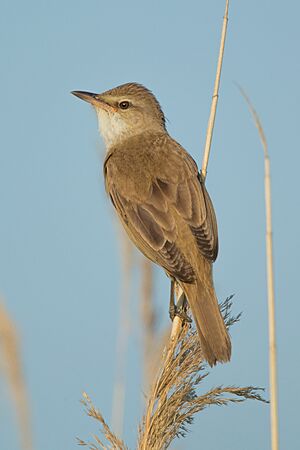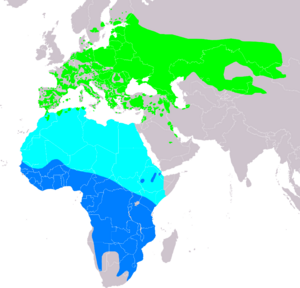Great reed warbler facts for kids
Quick facts for kids Great reed warbler |
|
|---|---|
 |
|
| An adult bird at a bird banding station | |
| Conservation status | |
| Scientific classification | |
| Genus: |
Acrocephalus (bird)
|
| Species: |
arundinaceus
|
 |
|
| Where the Great Reed Warbler lives Breeding Passage Non-breeding | |
| Synonyms | |
|
Turdus arundinaceus Linnaeus, 1758 |
|
The great reed warbler (Acrocephalus arundinaceus) is a bird found in Europe and Asia. It belongs to a group of birds called passerines.
The name Acrocephalus comes from Ancient Greek words meaning "highest" and "head". This might refer to the bird's pointed head. The second part of its name, arundinaceus, is Latin for "like a reed". This makes sense because these birds love living in reeds!
Great reed warblers used to be grouped with other "Old World warblers". Now, scientists know they are part of the Acrocephalidae family, which includes marsh and tree-warblers. These birds are medium-sized and are the biggest warblers in Europe. They breed across mainland Europe and western Asia. When winter comes, they fly all the way to sub-Saharan Africa.
During breeding season, they prefer to live in thick reed beds. In winter, they can be found in reed beds, bushy areas, rice fields, and forest clearings. Male and female great reed warblers look very similar. They can mate in different ways, sometimes with one partner (monogamy) and sometimes with multiple partners (polygyny).
Contents
About the Great Reed Warbler
This warbler is about the size of a thrush. It is one of the largest birds in its family, the Acrocephalidae. It grows to be about 16 to 21 centimeters (6 to 8 inches) long. Its wingspan is about 25 to 30 centimeters (10 to 12 inches). It weighs between 22 and 38 grams (0.8 to 1.3 ounces).
Adult great reed warblers have plain brown feathers on their backs. Their chin and belly are a dull, creamy white. They have a flat forehead and a strong, pointed beak. They look a lot like a giant Eurasian reed warbler. However, they have a stronger "eyebrow" stripe above their eye.
Both male and female great reed warblers look the same. Young birds have a richer, buff color on their undersides.
The song of the great reed warbler is very loud. You can hear it from far away. The main part of their song sounds like a chattering and creaking "carr-carr-cree-cree-cree-jet-jet". They also add whistles and copy sounds from other birds, just like marsh warblers do.
Where They Live and Travel

The great reed warbler breeds in Europe and western Asia. You won't find them breeding in Great Britain, but they visit there sometimes. In recent years, their numbers have grown around the eastern Baltic Sea. However, they have become rarer in the western parts of their range.
These birds are migratory. This means they fly to warmer places for winter. They spend their winters in tropical Africa. They migrate north quite late in the spring. Some birds stay in Africa until the end of April.
Even though there are no different types (subspecies) of this bird, scientists have found something interesting. During the last Ice Age, there were likely two separate groups of great reed warblers. These groups were probably separated by huge sheets of ice and empty lands.
Scientists think these groups became separated about 80,000 years ago. This was when the ice sheets first started to grow larger. The birds spread out again when the Ice Age ended about 13,000 years ago. Even today, the birds from western Europe tend to winter in western Africa. Birds from eastern Europe winter in eastern Africa.
From 2017 to 2019, tiny trackers were used to follow these birds. They tracked great reed warblers flying over the Mediterranean Sea and the Sahara Desert. These birds were traveling between their breeding grounds in Sweden and their winter homes in Africa.
When flying over the Sahara Desert, some birds flew incredibly high. They reached altitudes of over 5 kilometers (3 miles)! As of 2023, these are the highest flights ever recorded for birds. These heights are similar to the tops of the tallest mountains in Africa and Europe.
Why do they fly so high? It might help them avoid predators. It could also reduce the risk of getting too hot or losing too much water. Flying high might also help them see further.
These passerine birds live in large reed beds, often with some bushes. In their breeding areas, they protect their own territory. In their winter homes, they often gather in large groups. They might even take over a whole reed bed, keeping other birds out.
Like most warblers, they mainly eat insects. But they will also eat other small creatures. This includes small vertebrates like tadpoles.
The number of great reed warblers changes a lot over time. But they can quickly spread to new areas when there is new habitat. This bird is common and widespread. Because of this, it is considered a species of least concern by the IUCN. This means it is not currently at risk of extinction.
Behavior
What They Eat
The great reed warbler mostly eats meat, especially insects. During the breeding season, they have been seen catching insect larvae, moths, dragonflies, damselflies, beetles, spiders, small fish, and frogs. When it's not breeding season, they have also been reported to eat fruit. Young birds in the nest usually eat flies and spiders.
Communication and Courtship

Male great reed warblers use two main types of songs to communicate. One type is a short song, about one second long, with only a few sounds. The other is a long song, about four seconds long, with more sounds and it's louder.
Males mainly use the long songs to attract females. Only males without a partner sing these long songs. They stop singing them once a female arrives. The short songs are mostly used when males are defending their territory from other males.
In experiments, male great reed warblers did not like to go near recordings of short songs. If they were attracted by long songs, they would leave when the recording switched to short songs.
Usually, bird species that mate with only one partner (monogamous) use long, complex songs to attract mates. Birds that mate with multiple partners (polygynous) often use short, simple songs to defend their territory.
The size of a great reed warbler's song also seems to be important for their success. While the song size doesn't directly link to territory size or male qualities like wing length or age, it does link to the quality of their territory. Also, a better territory helps a male attract more females. A longer song repertoire is linked to how many young birds they produce.


